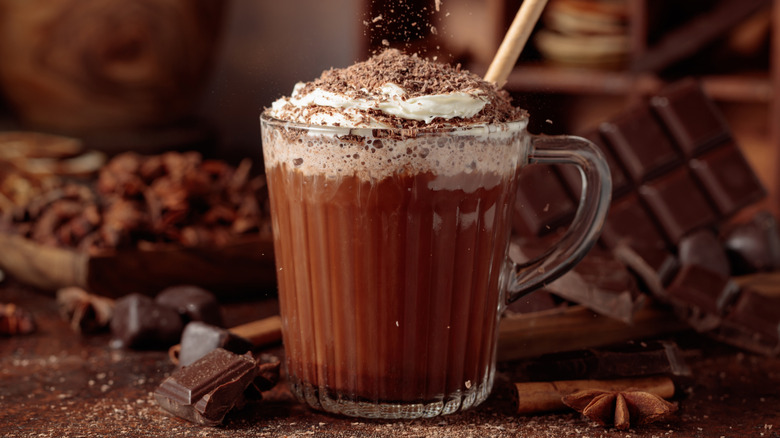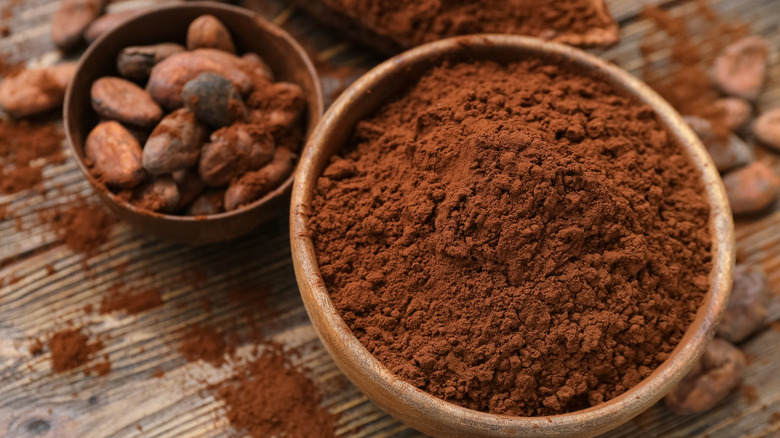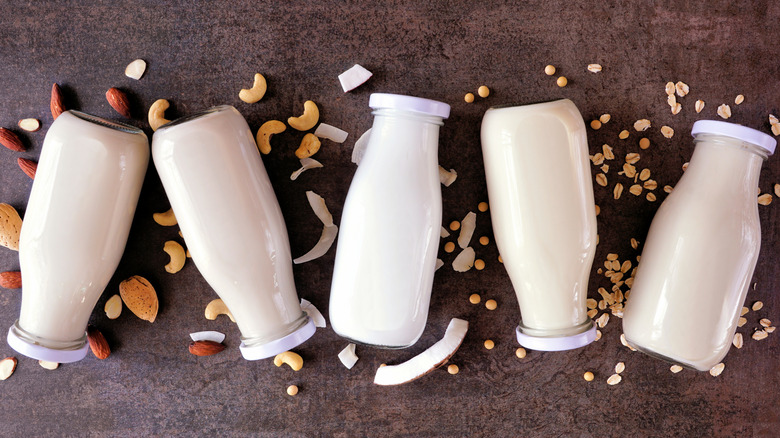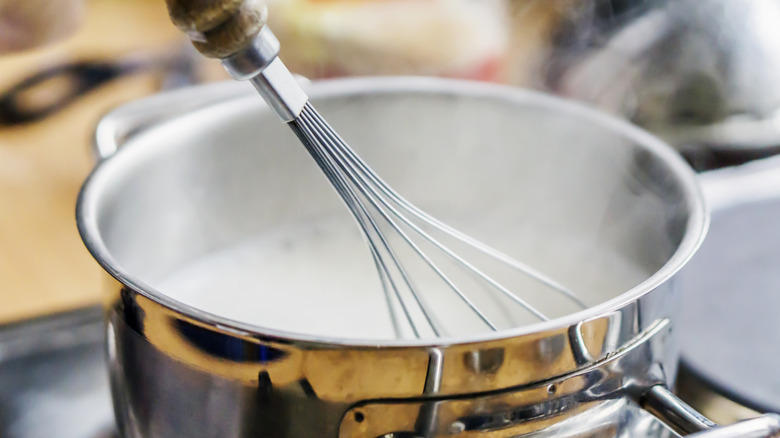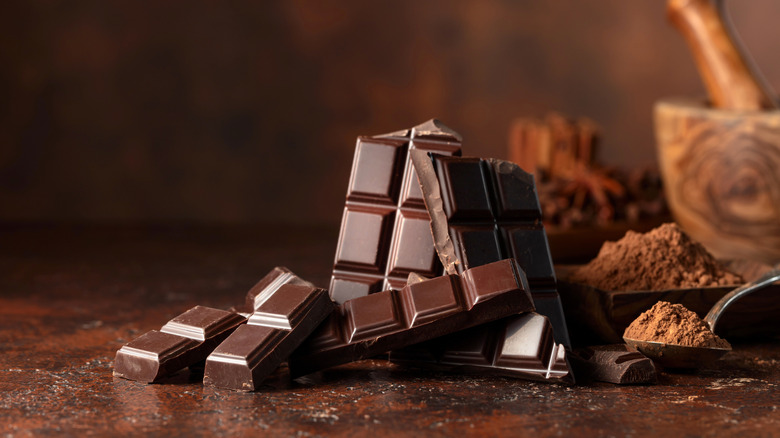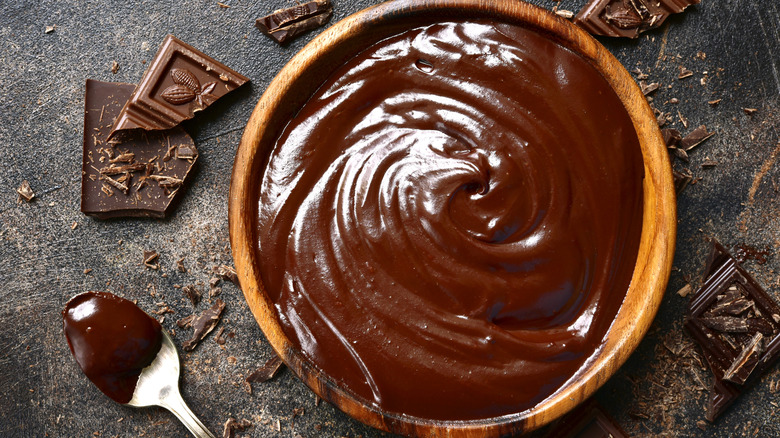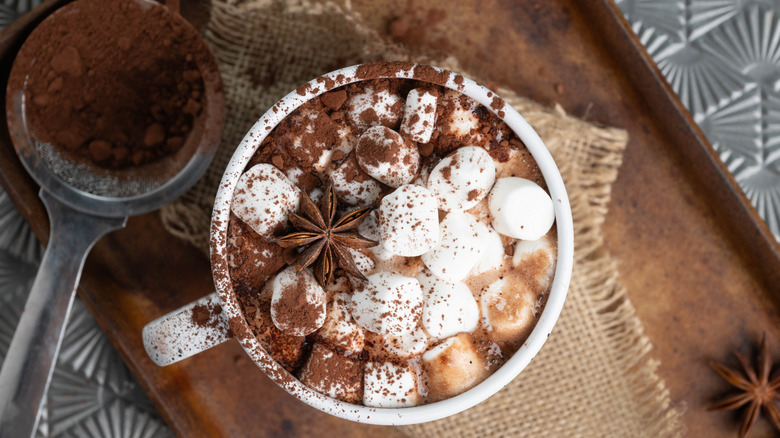11 Mistakes You Might Be Making With Homemade Hot Chocolate
There's no better way to warm up on a cold day than with a decadent mug of rich and creamy hot chocolate. Whether you like to enjoy it with your breakfast or use it as a way to relax and satisfy your sweet tooth at night, hot chocolate never disappoints. Unless you're making one of these common mistakes with your homemade hot cocoa, that is. You may think that there is no bad cup of hot chocolate, but if you skip a luscious topping or use the wrong type of milk, or — gasp — an instant, store-bought version, the results may be less than desirable. There's an art to crafting the perfect cup of hot chocolate, but thankfully, it's not as labor-intensive as it sounds.
We all know that not every bar of chocolate is created equally, and the same goes for hot chocolate. The sweet and creamy beverage is only as good as the ingredients you put into it, and skimping on anything, especially the quality of your cocoa powder, will be evident. The good news, though, is that it's easy to create the homemade hot chocolate of your winter dreams by just paying attention to a few key details. So grab your mug, whisk, and chocolate, and prepare to make a cozy cup.
Not choosing a good-quality cocoa powder
A good cup of hot chocolate begins with high-quality cocoa powder, so it's important to choose the best one you can afford. Unlike instant hot chocolate mixes, which often contain undesirable filler ingredients such as hydrogenated vegetable oil, cellulose gum, and corn syrup, high-quality cocoa powder is made from nothing but processed cocoa beans. Besides being delicious, natural cocoa powder is also nutritious, containing antioxidants and heart-healthy polyphenols. Who knew that drinking hot chocolate could be good for you? If you want to control the amount of sugar that goes into your homemade hot chocolate, it's important to choose unsweetened cocoa powder.
The difference between making a mug of hot chocolate and hot cocoa is that the latter contains only powder rather than solid chocolate. While you can enjoy it either way, each version has a different texture, with the hot chocolate having a thicker, creamier consistency. Drinking chocolate, as it's called, contains just melted chocolate and milk, making it the thickest of the options. If you're looking for a sweet, hot drink that is rich without being over the top, hot chocolate made with natural cocoa powder is the way to go.
Using hot water instead of milk
Another not-so-secret secret to making delectable homemade hot chocolate is using hot milk instead of boiling water. While using hot water right from the tap or kettle may be a slightly more convenient option than using milk, there's no doubt that the dairy is worth the effort. Due to its protein and fat content, milk will give your hot chocolate its signature rich and creamy consistency, while water will naturally thin the beverage out. If you're looking for a more indulgent way to warm up on a chilly day, making your hot chocolate with milk is definitely the way to go. While you may remember just adding hot water to your packet of hot chocolate when you were a child, that worked because the store-bought version contains "dairy product solids," which create a creamier beverage when boiling water is added.
When you're making hot chocolate from scratch, the all-natural cocoa powder doesn't contain any dairy, so the drink only gets its decadent texture from the milk you add. Depending on your preference, you can use any type of milk in your hot chocolate, from fat-free skim to full-fat cream. Other options include 1% and 2% milk, along with whole milk, all of which contain varying levels of fat. You can also create a perfect blend by combining a few types of milk, such as skim and whole, or even some hot water along with the dairy to thin the beverage out a bit. For an over-the-top taste experience, go with chocolate milk instead of plain.
Mixing with milk (dairy or non-dairy) that isn't creamy
One of the things that makes hot chocolate such an enticing winter beverage is its creamy, dreamy texture. That's why using either dairy or non-dairy milk instead of water when making the drink is typically recommended. Not only does milk give the hot chocolate a smooth and velvety consistency, but it also adds more flavor than water. As a general rule, the more fat milk contains, the creamier the hot chocolate will be due to the thicker mouthfeel. High-fat dairy adds a richness to the cozy, chocolatey beverage that water alone cannot. Dairy with high levels of fat includes cream, half-and-half, and whole milk. For comparison, whole milk contains about 3.25% milk fat, while 2% milk has, you guessed it, 2% milk fat. While whole milk will have a creamier, more indulgent texture, 2% is a good option if you want to cut back on calories while still having a rich beverage.
If you're thinking of swapping regular milk with plant-based alternatives, consider using one that contains natural fats, such as coconut milk. Coconut is often used as a substitute for heavy cream in recipes and can even be used to make fluffy whipped cream. Soy milk is a bit thinner than its coconut counterpart, but it is known for its traditional "milky" flavor. Other creamy non-dairy substitutes that you can include are oat and rice.
Curdling the milk
No one wants to experience curdled milk when sipping a mug of delicious hot chocolate. The fastest way to ruin the consistency of this traditionally smooth and creamy beverage is with lumpy milk. Dairy milk contains a mixture of water, proteins, and butterfat, which break apart when the liquid is boiled. During the boiling process, the proteins coagulate and separate from the water, forming the unwanted curds. To avoid bumpy hot chocolate, be careful not to boil the milk. Instead, pour the milk into a saucepan and heat it up until it's steaming hot, but not yet boiling. To make sure you don't cross the line, you can insert a thermometer into the hot milk. Aim for approximately 180 degrees Fahrenheit, which isn't quite at the boiling point, yet still puts the hot in hot chocolate.
Consider using a stovetop to boil the milk rather than your microwave, as it's easier to control the temperature when you keep your eye on it. Also, avoid freezing the hot chocolate to thaw and enjoy later, as it may have a lumpy consistency when it's reheated.
Failing to pre-mix the cocoa powder or chocolate with liquid first
If you're in a hurry and want to treat yourself to a creamy cup of hot chocolate in just a matter of minutes using a few ingredients, you won't be disappointed. The most important tip to keep in mind, however, is to premix the cocoa powder with a liquid, either water or milk, before making the hot chocolate. The same rule applies if you're using melted chocolate in your recipe as well. The trick is to melt the chocolate in your microwave first, and then blend it and the cocoa powder with a small amount of liquid to form a thick paste.
Once the chocolatey paste is formed, you can then slowly stir in the remaining milk or hot water until it's thoroughly incorporated. You can either add the paste to a saucepan of almost-boiling milk or water, or stir in cold liquid and then heat it in your microwave. No matter what way you choose to heat and prepare your hot chocolate, gently incorporating the paste into the liquid is a key step in creating a smooth, well-blended beverage.
Skipping the solid dark or semi-sweet chocolate
Sure, you can enjoy a cup of hot cocoa on a cold winter day and feel satisfied by the sweet treat. But if you want to elevate your beverage to "hot chocolate," you must include one crucial ingredient — the actual chocolate. Along with the highest quality cocoa powder you can afford, it's important to use a chocolate bar that you'd enjoy eating on its own as well, unless you opt to go the unsweetened route. Incorporating dark or semi-sweet chocolate into your hot drink is a smart idea because it allows you to control the sweetness level, and is one way to make hot chocolate so rich it coats your spoon. If you use traditional milk chocolate, the beverage may end up being too sweet, but you can sweeten a drink made with dark or semi-sweet chocolate to your liking. It's always easier to add sugar rather than take it away when making hot chocolate.
Using dark chocolate (here's why dark chocolate is considered healthier than other types) in your recipe will give you that super-intense chocolate flavor without any of the sugar. This is especially helpful if you plan to add granulated sugar or a flavored syrup to your hot chocolate. Semi-sweet chocolate is slightly sweeter, but has a richer mouthfeel than its dark counterpart. Depending on what you have on hand, you can either use a solid chocolate bar or chips.
Improperly melting the chocolate
After you've chosen the type of chocolate you want to use to make your tasty hot beverage, the next step is melting it properly. The good news is that there are a few different ways to do it, depending on how much time you want to spend in the kitchen. One way to melt chocolate quickly is by heating it in the microwave. Like cocoa powder, it's important to use the highest-quality chocolate bar or chips possible to ensure the smoothest, creamiest consistency and best flavor. If you're not sure if yours is from a gourmet candy shop or the dollar store, there's an unexpected trick to tell if chocolate is high quality. If you're using a chocolate bar, chop it up into small pieces before melting it. The finer the chopped chocolate is, the easier and faster it will melt down.
One way to melt the chocolate is by placing it into a microwave-safe bowl and microwaving it in 30-second increments until it's smooth, creamy, and shiny. Pulling the chocolate out and stirring it during the heating process will allow it to melt evenly. After the chocolate is thoroughly melted, you can either make it into a paste using a small amount of liquid or slowly stir it into the hot milk as is.
Not blending the ingredients with a whisk
Another way to make sure your hot chocolate is the smoothest-sipping beverage possible is by blending all of the ingredients with a whisk rather than a spoon. Using a whisk offers several benefits and ensures a silky smooth cup of hot chocolate. First of all, a whisk ensures that the cocoa, melted chocolate, sugar, and hot milk are well-blended. It also incorporated air into the mixture, giving the drink a velvety consistency. When making your homemade hot chocolate, start by whisking together the dry ingredients, such as cocoa powder, sugar, and spices such as cinnamon.
Next, add the melted chocolate or chocolate paste to the hot milk, and blend the ingredients with a whisk until they're creamy. Whisk slowly and steadily as the chocolate melts seamlessly into the liquid, aerating the mixture as you go. If you're heating the milk in a saucepan on your stovetop, set the temperature to medium-low as you whisk in the chocolate, and be sure to remove it from the burner just before it starts to boil.
Forgetting a pinch of salt and vanilla extract
Although the taste of melted chocolate, cocoa powder, and rich milk is addictive enough on its own, adding a pinch of salt and a bit of vanilla extract can take your hot drink to the next level of deliciousness. You may be surprised by the thought of adding salt to such a sweet beverage, but it actually enhances the rich chocolate flavor. Using just a small pinch of salt will accentuate the intense chocolate taste without making the drink salty. The salt will also help balance out the flavors in the hot beverage, and can also suppress any bitterness in dark or semi-sweet chocolate.
As for the vanilla, just a dash of a good-quality extract will elevate the flavor of the chocolate rather than cancel it out. Similar to salt, vanilla can balance out the drink's sweetness, as well as cancel bitterness. Vanilla may help mellow out any sharp notes in intense dark chocolate or cocoa powder. For hot chocolate aficionados, vanilla extract adds another layer of complexity to the drink without being overwhelming.
Choosing not to creative with additions
Although you may crave a simple, comforting cup of hot chocolate in its purest form at times, certain occasions call for a bit more creativity with additions such as dried ancho chilies and other spicy elements. Adding just a pinch of unexpected spices can transform your favorite childhood beverage into something a bit more grown-up. (It's also one of 16 unique ways to make hot chocolate even better.) Consider sprinkling in some cinnamon for a Mexican hot chocolate-inspired drink, or a dash of cayenne to heat things up a little. Another way to add delicious flavor to your homemade hot chocolate is with flavored syrups and natural extracts, including warm and cozy hazelnut and almond or festive peppermint for the holidays.
If you're planning a wintertime event, consider setting up a hot chocolate bar and allowing guests to get crafty with their cups. Provide plenty of rich and creamy hot chocolate, as well as flavorful additions that partygoers can mix and match according to their tastes. For instance, set out bowls of crushed cinnamon and peppermint sticks, miniature peanut butter cups, white and dark chocolate shavings, toffee bits, and coarse sea salt for those who prefer a more savory twist. Other surprisingly tasty hot chocolate additions include anise, Chinese five spice, ground vanilla beans, and dried citrus peels.
Forgoing a decadent topping
Is it even possible to make a rich, creamy, and well-balanced cup of hot chocolate even better? It sure is, with the right toppings. Forgoing a decadent topping on a perfect batch of homemade hot chocolate isn't a terrible mistake, but you won't be doing yourself any favors. The best hot chocolate toppings are all about enriching an already delicious beverage, while also adding aesthetic value. If you want to stick to the classics, you can never go wrong with a fluffy dollop of whipped cream on top of your hot chocolate. Sprinkle that with some colorful sprinkles or some fresh chocolate shavings, and you can't get a much better winter drink.
Of course, you can't forget the mini marshmallows, especially if you're serving the hot chocolate to children or adults who are kids at heart. Other yummy drink toppings include caramel and chocolate sauces, crushed peppermint sticks or crumbled gingerbread cookies during the holiday season, chopped toffee, butterscotch chips, and toasted coconut flakes as a tropical twist.
